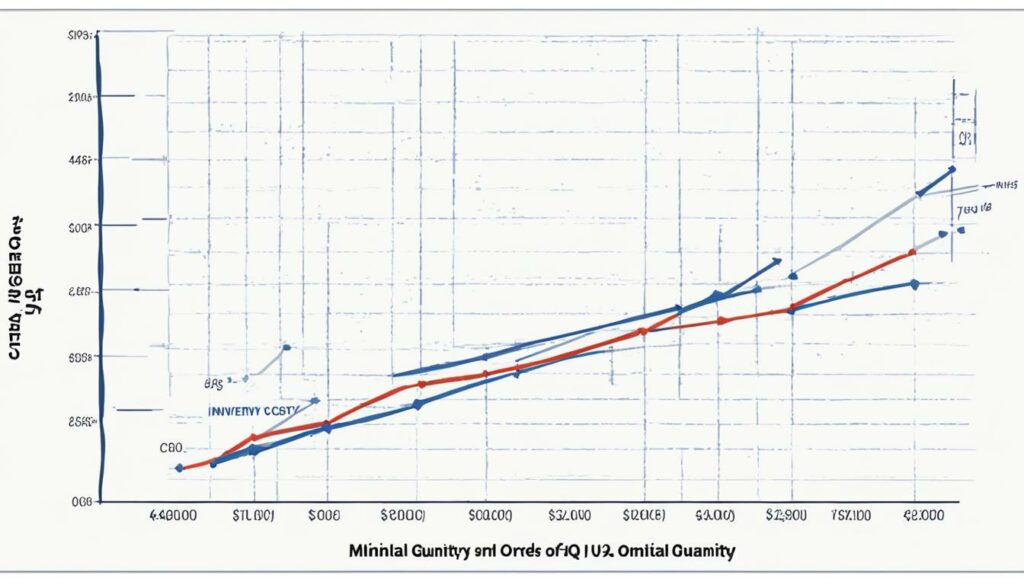Economic Order Quantity (EOQ) is a crucial concept in inventory management that helps businesses optimize their order quantity and minimize costs. EOQ considers various factors such as demand, holding costs, and order costs to determine the most optimal order size.
For ecommerce businesses, managing inventory efficiently is essential for smooth operations and customer satisfaction. By implementing EOQ, businesses can strike the right balance between stocking enough inventory to meet customer demand and avoiding excessive inventory that ties up capital and incurs holding costs.
EOQ is calculated using a simple formula: √ [2DS/H]. In this formula, D represents the annual demand for a product, S represents the order cost, and H represents the holding costs. By plugging in these variables, businesses can determine the optimal order quantity that minimizes costs.
Key Takeaways:
- Economic Order Quantity (EOQ) helps businesses optimize their inventory management practices by determining the ideal order quantity.
- EOQ takes into account factors such as demand, holding costs, and order costs to minimize expenses and maximize profitability.
- Implementing EOQ in ecommerce can enhance customer satisfaction by ensuring sufficient inventory levels without excessive stockouts or overordering.
- The EOQ formula, √ [2DS/H], provides a simple calculation to determine the optimal order quantity.
- By incorporating EOQ into their inventory management strategies, businesses can streamline operations and improve financial performance.
Introduction to Economic Order Quantity (EOQ)
Economic Order Quantity (EOQ) is a metric that plays a crucial role in effective inventory management. By determining the optimal order size, businesses can minimize costs associated with inventory and maximize profitability. EOQ takes into consideration factors such as demand, holding costs, and order costs to find the ideal balance.
EOQ is widely used across various industries and is applicable to businesses of all sizes and types. Whether it’s a large-scale manufacturing company or a small e-commerce store, EOQ provides valuable insights to optimize inventory control.
The primary objective of calculating EOQ is to strike the right balance between the costs of ordering and holding inventory. By optimizing the order quantity, businesses can minimize the amount of money tied up in inventory and reduce storage expenses without compromising on meeting customer demand.
Now, let’s delve deeper into how EOQ is calculated and how it can benefit businesses in optimizing their inventory management.

| Benefits of EOQ | Challenges of EOQ |
|---|---|
|
|
Calculating Economic Order Quantity (EOQ)
Calculating the Economic Order Quantity (EOQ) is an essential step in effective inventory management. By considering factors such as demand, order cost, and holding costs, businesses can determine the optimal order size to minimize expenses and maximize profitability.
The EOQ formula, √ [2DS/H], allows businesses to calculate their EOQ based on these variables:
- D: Annual demand for a product
- S: Order cost
- H: Holding costs
By plugging these values into the formula, businesses can find the ideal order quantity that minimizes holding costs and excess inventory while meeting customer demand.
Here is an example of how the EOQ calculation works:
Let’s assume that a business has an annual demand for a specific product of 1,000 units (D), an order cost of $50 (S), and holding costs of $1 per unit per year (H). Plugging these values into the EOQ formula, we have:
EOQ = √ [2 * 1000 * 50 / 1]
EOQ = √ [100000 / 1]
EOQ ≈ √ 100000 ≈ 316.23
In this example, the calculated EOQ is approximately 316 units. This means that the business should place orders of around 316 units at a time to minimize costs and maintain an optimal inventory level.
Calculating the EOQ is crucial for businesses to optimize their inventory management practices and ensure smooth operations. By determining the optimal order size, businesses can minimize holding costs, reduce the risk of stockouts, and improve overall profitability.
Importance of Economic Order Quantity (EOQ) in Ecommerce
Economic Order Quantity (EOQ) plays a crucial role in the success of ecommerce businesses. By accurately calculating the optimal order size, businesses can strike a balance between meeting customer demand and minimizing costs. This section explores the significance of EOQ in inventory management and its impact on ecommerce profitability.
Effective inventory management is essential in ecommerce, where customer expectations for fast and reliable product delivery are high. By implementing EOQ, businesses can ensure that they have enough stock to fulfill orders without excessive inventory carrying costs or stockouts. Achieving this balance is critical to maintaining customer satisfaction and loyalty.
EOQ helps businesses optimize their inventory management practices by minimizing various costs associated with inventory, storage, and ordering. By calculating the optimal order quantity, businesses can avoid overordering, reducing the risk of excess inventory that ties up capital and incurs unnecessary holding costs. Similarly, EOQ helps businesses prevent underordering, providing them with enough stock to meet customer demand and avoid costly stockouts that lead to lost sales and dissatisfied customers.
Implementing EOQ in ecommerce can also enhance the overall customer experience. By accurately managing inventory levels, businesses can consistently fulfill customer orders, leading to faster delivery times and improved customer satisfaction. In an industry where speed and reliability are key factors influencing purchase decisions, effective inventory management through EOQ can give businesses a competitive edge.
“EOQ allows ecommerce businesses to strike a balance between meeting customer demand and minimizing costs.”
Furthermore, by optimizing inventory levels, businesses can free up capital that would otherwise be tied up in excessive inventory. This capital can then be reinvested in other areas of the business, such as marketing initiatives, product development, or expanding operations. EOQ, therefore, directly impacts the financial performance of ecommerce businesses, leading to increased profitability and improved long-term sustainability.
It is worth noting that EOQ is not a one-time calculation but an ongoing process that requires regular monitoring and adjustment. Customer demand patterns, market dynamics, and internal operational factors can change over time, necessitating periodic reassessment of the EOQ calculation. By continuously refining and optimizing EOQ, businesses can adapt to changing market conditions and maintain a competitive advantage in the ecommerce industry.

Summary Table: Benefits of Economic Order Quantity (EOQ) in Ecommerce
| Benefits | Explanation |
|---|---|
| Optimal order size | Ensures businesses have enough stock to meet customer demand without overordering or underordering. |
| Cost minimization | Reduces costs associated with inventory, storage, and ordering, leading to improved profitability. |
| Avoidance of stockouts | Prevents lost sales and dissatisfied customers by ensuring adequate stock levels. |
| Enhanced customer experience | Improves order fulfillment, delivery times, and overall customer satisfaction. |
| Capital optimization | Frees up capital by minimizing excess inventory and reinvesting it in other business areas. |
| Improved profitability | Impact on financial performance through reduced costs and increased efficiency. |
Strategies to Improve Economic Order Quantity (EOQ) in Ecommerce
In order to enhance their Economic Order Quantity (EOQ) in ecommerce, businesses can implement various effective strategies. These strategies focus on optimizing order fulfillment, better forecasting, and demand planning, as well as negotiating bulk discounts with suppliers.
1. Optimize Order Fulfillment
Optimizing order fulfillment plays a crucial role in improving EOQ in ecommerce. By ensuring that products are always available when needed, businesses can avoid stockouts and meet customer demand effectively. One strategy to achieve this is implementing a continuous review system, which constantly monitors inventory levels and triggers the reordering process when a predetermined threshold is reached.
Additionally, setting up automatic reorder points is another effective strategy. This involves establishing minimum inventory levels that, once reached, automatically generate orders to replenish stock. By implementing these strategies, businesses can maintain optimal inventory levels and prevent overordering or underordering.
2. Leverage Forecasting and Demand Planning Tools
Accurate forecasting and demand planning are essential for improving EOQ in ecommerce. By leveraging advanced forecasting tools and analyzing historical sales data, businesses can better predict customer demand. This enables them to adjust their EOQ calculations accordingly, ensuring that the optimal order size is consistently met.
Implementing demand planning tools can also provide valuable insights into seasonality, customer preferences, and buying habits. By aligning inventory levels with customer behavior patterns, businesses can make informed decisions to optimize their EOQ and minimize unnecessary inventory holding costs.
3. Negotiate Bulk Discounts with Suppliers
Another effective strategy to improve EOQ in ecommerce is negotiating bulk discounts with suppliers. By purchasing larger quantities of products, businesses can enjoy cost savings, resulting in lower order costs. This can significantly improve the overall EOQ and enhance profitability.
Building strong relationships with suppliers and collaborating on long-term contracts can provide businesses with leverage to negotiate better prices and favorable terms. By reducing order costs, businesses can optimize their inventory management practices and ensure an efficient EOQ calculation.
Summary
Implementing these strategies can greatly improve a business’s Economic Order Quantity (EOQ) in ecommerce. By optimizing order fulfillment, leveraging forecasting tools, and negotiating bulk discounts, businesses can enhance their inventory management practices and achieve better financial performance. It is crucial for businesses to continuously review and refine their EOQ strategies to stay competitive in the dynamic ecommerce landscape.

| Strategies | Benefits |
|---|---|
| Optimize order fulfillment | – Avoid stockouts – Meet customer demand effectively – Prevent overordering or underordering |
| Leverage forecasting and demand planning tools | – Accurately predict customer demand – Adjust EOQ calculations accordingly – Minimize inventory holding costs |
| Negotiate bulk discounts with suppliers | – Lower order costs – Improve overall EOQ – Enhance profitability |
Customer Behavior and Economic Order Quantity (EOQ)
When it comes to calculating Economic Order Quantity (EOQ), customer behavior plays a vital role. By closely analyzing customer demand patterns and purchasing behaviors, businesses can gain valuable insights that can greatly optimize their EOQ calculations. Understanding customer preferences, buying habits, and seasonality allows businesses to accurately predict demand and determine the optimal order size.
By aligning their inventory management practices with customer behavior, businesses can effectively minimize costs, improve order fulfillment, and enhance the overall customer experience. This not only leads to improved profitability but also ensures that businesses are meeting customer expectations and demands.
“By effectively incorporating customer behavior into EOQ calculations, businesses can accurately anticipate demand and adjust their inventory levels accordingly, resulting in optimized inventory management.”
Insights from Customer Behavior Analysis
Customer behavior analysis provides businesses with key insights that can have a significant impact on EOQ. Here are some important factors to consider:
- Purchase Frequency: By analyzing how often customers make purchases, businesses can identify the ideal order frequency and adjust EOQ accordingly. This ensures that there is sufficient stock available to meet the demand.
- Order Size: Understanding the average order size allows businesses to optimize EOQ calculations by determining the right quantity of products to order. This ensures that businesses are not faced with excess inventory or stockouts.
- Seasonality: Recognizing seasonal variations in customer demand helps businesses accurately anticipate fluctuations in sales and adjust EOQ calculations accordingly. This prevents overstocking during slow seasons and avoids stockouts during peak seasons.
- Product Preferences: Identifying customer preferences for specific products allows businesses to align their EOQ calculations with the demand for those products. This helps in effectively managing inventory levels for each product category.
By leveraging these insights and aligning EOQ calculations with customer behavior, businesses can optimize their inventory management practices, minimize costs, and enhance customer satisfaction. This ultimately contributes to long-term business growth in the ecommerce industry.
Visual Representation of EOQ and Customer Behavior
To further illustrate the relationship between EOQ and customer behavior, let’s take a look at the following table:
| Customer Behavior | Impact on EOQ |
|---|---|
| Purchase Frequency | Affects the order frequency and quantity |
| Order Size | Directly influences the order size and frequency |
| Seasonality | Adjusts EOQ calculations based on seasonal variations |
| Product Preferences | Determines the demand for specific products and adjusts EOQ accordingly |
Through a comprehensive analysis of customer behavior and its impact on EOQ, businesses can effectively optimize their inventory management practices, ensure sufficient stock levels, and deliver an exceptional customer experience.

Economic Order Quantity (EOQ) and its Relation to Other Metrics in Ecommerce
Economic Order Quantity (EOQ) is a fundamental concept in inventory management that directly impacts various metrics in ecommerce. By determining the optimal order quantity, businesses can effectively control their inventory levels and reduce holding costs, leading to improved efficiency and profitability.
One metric closely related to EOQ is inventory turnover. EOQ helps businesses strike a balance between having enough stock to meet customer demand and avoiding excess inventory. By optimizing their order quantity calculation using EOQ, businesses can minimize holding costs and maintain an optimal level of inventory turnover.
In addition to inventory turnover, EOQ also influences profitability. By accurately calculating the order quantity, businesses can reduce unnecessary expenses associated with inventory management. This includes costs such as storage and obsolescence, maximizing their profitability and overall financial performance.
Furthermore, EOQ can be effectively utilized in conjunction with other metrics like reorder point and safety stock. By considering EOQ in relation to these metrics, businesses can ensure stable and efficient inventory control, minimizing the risk of stockouts and inventory shortages.
FAQ
What is Economic Order Quantity (EOQ)?
Economic Order Quantity (EOQ) is a calculation that helps businesses determine their ideal order size in order to minimize costs and maximize profitability. It takes into account factors such as demand, holding costs, and order costs. EOQ is applicable to all businesses that manage inventory and can greatly improve their inventory management practices. It is a useful tool for optimizing inventory levels and ensuring that businesses have enough stock to meet demand without overordering or underordering.
How can I calculate Economic Order Quantity (EOQ)?
The calculation of Economic Order Quantity (EOQ) involves three variables: demand, order cost, and holding costs. The EOQ formula is √ [2DS/H], where D represents the annual demand for a product, S represents the order cost, and H represents the holding costs. By plugging these variables into the formula, businesses can calculate their EOQ and determine the optimal order size for their inventory. This calculation helps businesses minimize holding costs and excess inventory, while still meeting customer demand.
Why is Economic Order Quantity (EOQ) important in ecommerce?
Economic Order Quantity (EOQ) is of great importance in ecommerce. By determining the optimal order size, businesses can ensure that they have enough stock to meet customer demand without overordering or underordering. EOQ helps businesses minimize costs associated with inventory, storage, and ordering, leading to improved profitability. It also helps businesses avoid stockouts, which can result in lost sales and dissatisfied customers. Effective inventory management through EOQ can enhance the overall customer experience and drive business growth in the ecommerce industry.
What strategies can I implement to improve Economic Order Quantity (EOQ) in ecommerce?
There are several strategies that businesses can implement to improve their Economic Order Quantity (EOQ) in ecommerce. One strategy is to optimize order fulfillment to ensure that products are always available when needed. This can involve implementing a continuous review system and setting up automatic reorder points. Another strategy is to leverage forecasting and demand planning tools to accurately predict customer demand and adjust EOQ calculations accordingly. Additionally, businesses can negotiate bulk discounts with suppliers to lower their order costs and improve their overall EOQ. By implementing these strategies, businesses can optimize their inventory management practices and enhance their financial performance.
How does customer behavior impact the calculation of Economic Order Quantity (EOQ)?
Customer behavior plays a significant role in the calculation of Economic Order Quantity (EOQ). By analyzing customer demand patterns and purchasing behaviors, businesses can gather valuable insights to optimize their EOQ calculations. Understanding customer preferences, buying habits, and seasonality can help businesses accurately predict demand and determine the optimal order size. By aligning their inventory management practices with customer behavior, businesses can minimize costs, improve order fulfillment, and enhance the overall customer experience.
How does Economic Order Quantity (EOQ) relate to other metrics in ecommerce?
Economic Order Quantity (EOQ) is closely related to other important metrics in ecommerce. It has a direct impact on inventory turnover, as EOQ helps businesses maintain an optimal level of inventory and minimize holding costs. EOQ also affects profitability, as it helps businesses reduce unnecessary expenses associated with inventory management. Additionally, EOQ can be used in conjunction with metrics such as reorder point and safety stock to ensure stable and efficient inventory control. By considering EOQ in relation to other metrics, businesses can optimize their inventory management practices and achieve better financial results.
